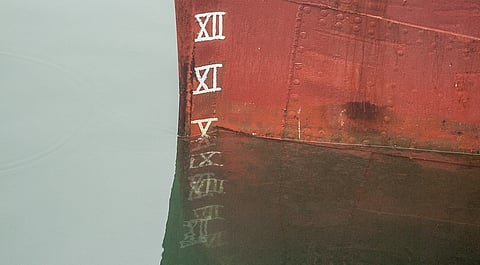

As with any well-run ship, a regular task in port, for some responsible officer, was to read the draught marks on bow and stern.
It was important, for several obvious reasons in that it helped to keep a permanent track on the stability, and was a physical check on the weights that had been taken off, or put on, the ship, in terms of cargo, or bunkers consumed, on a voyage.
It helped to verify all our calculations and showed up any major differences between the weight of cargo the stevedores said they had handled, and reality. It also provided some reassurance that we hadn't sunk, and were sitting on the bottom.
Reading the draught wasn't exactly rocket science, although it could be tricky if the ship was a long way off the quay, it was night, and your torch was getting a bit feeble. It didn't make life easier if the ship was moving about, or the waves were slopping around the waterline, when you just had to try and average out the mean figure.
And because we never quite trusted the inclinometer on the bridge to tell us the ship was on an even keel. If you wanted to be very accurate it meant reading the draught marks on the offshore side of the ship, hanging over a ladder, lashed to the rail on the poop and taking a mean between port and starboard sides.
I recall once when reading the offshore draught in London's docks, with the ship surrounded with barges, I thought I would save myself a climb and walk across a few of these useful craft to observe my marks. It was a beautiful calm morning and of course, the blooming watermen hadn't bothered to tie up their craft, so the action of jumping onto the last barge caused it to slowly drift off into the dock, while I was reading the figures and admiring the view. I thought I was going to be marooned for hours, but somebody saw me and flung me a line.
It was an altogether happier operation on a ship which had just tied up in the wonderful Western Samoan port of Apia, when rather than risking life and limb on a ladder, I was taken around the ship by a couple of lissom ladies in a canoe, the entire crew radiating envy that you could almost feel. I was sad to be returned to shore, but the master thought I had jumped ship and had disappeared for ever.
Rather less agreeable was my going ashore in the Canadian lake port of Hamilton to read the draught, shortly after our arrival up the Seaway from Montreal. Strangely, there had been nobody on the quay to take our lines, but assumed that the Seaway Drill applied and landed our sailors, with our little boom, to do the job, as if we were in the locks.
We landed the gangway and I set off with my little notebook, only to be set upon by a deranged looking individual who leaped out from behind a warehouse dragging a revolver out of his holster and shouting in incomprehensible Canadian.
It took me some time to realise that this was the watchman on this berth and he was going to shoot me full of holes if I didn't get back aboard and take my ship away. I tried to reason with him as one does – "You can't shoot me, I'm a British officer" – but that seemed to make him even more determined, so I beat a hasty retreat, followed by a torrent of expletives. At least they weren't bullets.
It turned out that the pilot, who was as unfamiliar with the port as we were, had berthed us in the wrong place, so we left him to reason with the mad gunman and warped the ship a quarter of a mile along the quay, to where the natives were rather more welcoming. I recall suggesting that I deserved a war bonus for such an ordeal.
Our true draught also depended on the density of the water we happened to be floating in, which was something we always tested, before leaving a port. It was important, because the same weight of ship would register very different draughts if floating in the pristine waters of New Zealand, compared to some upriver berth or enclosed dock with the consistency of Brown Windsor soup.
That routine operation was simple enough, with a hydrometer and a bucket on the end of a heaving line, to obtain a sample of the harbour, river or dock. A shipmate told me of a strange experience sampling the water before sailing from a Queensland port, when, with the light of his torch, he saw the hydrometer disappear beneath the surface of the water in the bucket, only to bob up again.
Befuddled with sleep (he had been dragged out of his bunk a few minutes earlier) he put the hydrometer back in the bucket only to see it practically flung out as if by some unseen force. Thoughts of sea-monsters, and haunted buckets crossed his mind (we seafarers are inclined to superstition), but on closer inspection he discovered that the bucket contained, in addition to river water, a huge and obviously angry jellyfish that objected to the sharp end of a hydrometer being stuck into its head.
I suppose they still go through these little rituals on today's ships, although I wouldn't be surprised if remote electronics do the job for them, or even a drone buzzing around the offshore side of the poop, to save the third mate from any acrobatics.
Submissions wanted! Do you have an exciting, amusing or downright dangerous anecdote from your time in the maritime world? Each week, we will feature new personal experiences from across the globe. Submissions to: marinfo@baird.com.au.
